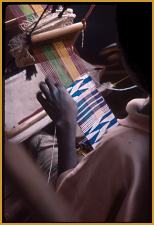|
The specific looms used by
Samuel Cophie (and other Kente cloth weavers) are both
similar and different from the simple West African strip
loom. The looms are similar in terms of treadles and the
extension of the warp into the compound—but this loom is
not created from the limbs and branches of trees. These
looms are the result of expert carpentry work. They are set
upon a platform, with the upper beams being notched or
serrated—these notched beams support the heddles and the
beater and give the weaver greater flexibility.
The Ashante weavers often use
two (sometimes three) pairs of heddles—this enables
the weaver to alter the colors within the warp and is called
"double weave" by the Ashante and Ewe weavers
(this "double weave" differs from the western
"double weave"). The first pair of heddles weave
what is called the "asatia" (tabby)—the
remaining heddles control the threads which weave the
pattern. Weavers that do not use these extra heddles use the
pick-up method for patterning.
The drag stone for the
Ashante loom is placed on rollers. The warp is knotted and
tied to the rocks or bricks with a clip or stick. In my
observations this particular loom is used primarily by the
Ashante weavers in the Kumasi area of Ghana (west central
Ghana) and the Ewe weavers in the Southeastern part of
Ghana. In the other areas of West Africa that I have visited
the simpler loom is used.
As simple as these looms are
they command great respect from the West African weaver. The
weaver not only has to be able to construct his own loom—he
also has to care for it. Old looms can not be broken up for
firewood or used for any purpose other than weaving. The
entire loom if it is no longer in use has to be thrown into
the river. The loom according to Eric Broudy is
"regarded as a household deity, a protector of the
home". If any criminal or adulterous act is committed
with the weaver’s home a sheep has to be sacrificed to the
loom and to the Chair of the ancestors.
 Weaving on these narrow
strips looms is a man’s activity. The art of weaving is
taught to young boys at a very early age—somewhere between
five and six. These young boys are taught initially how to
wind skeins, load shuttles and thread the reed and heddles—the
latter job is not easy task. As he grows he is taught how to
weave plain weaves, stripes and simple patterns. To weave
the complex Kente or Ewe patterns he must be a skilled and
practiced weaver. Weaving on these narrow
strips looms is a man’s activity. The art of weaving is
taught to young boys at a very early age—somewhere between
five and six. These young boys are taught initially how to
wind skeins, load shuttles and thread the reed and heddles—the
latter job is not easy task. As he grows he is taught how to
weave plain weaves, stripes and simple patterns. To weave
the complex Kente or Ewe patterns he must be a skilled and
practiced weaver.
Through tradition and a
variety of taboos women do not weave—although I have seen
photographs of several women weaving Kente cloth and Mr.
Cophie said there is one woman weaver in Bonwire. However,
throughout West Africa women are traditionally excluded from
strip weaving. Women are in some areas even excluded from
the environs of the loom. Captain R. S. Rattray in his book Ashanti
stated that in the Ashante culture "women could never
be weavers owning to the fact that they have menstrual
periods…a woman during her periods may not touch a loom. A
woman in this condition must not even address her husband
directly". It is also generally believed that the women
who do weave Kente cloth will become infertile.
According to Anne Spencer (Wrapped
in Pride) several organizations—The Centre for the
Development of People, The Anglican Diocesan Mothers’
Union and the Trinity Church I New York City—have all
sponsored The Bonwire Anglican Women Kente Project and claim
to have trained twenty women to weave. Another project in
the 1980’s near Agbozume also taught women to weave Kente
(or Ewe) cloth, but this project was abandoned in the mid
1990’s.
Women in West Africa do weave—however,
they weave on looms other than the strip looms. In Togo and
Cameroon women weave wider fabrics on the upright single
heddle looms and in Nigeria women weave on horizontal single
heddle looms. Women in many West African countries spin and
dye yarns. They are also the primary sellers of woven cloth
in the markets.
|